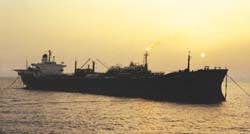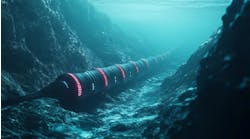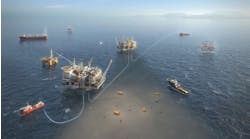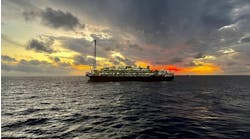West Africa's calm waters have ignited an explosion in demand for FPSOs
Rick Von Flatern
Technology Editor
The Ocean Producer at work for Sonangol on Angola Block 4 Tiabo Field.Though the concept has existed for more than 20 years, the oil and gas industry has only recently become enthusiastic about floating production, storage, and offloading (FPSO) vessels. Today 65 FPSOs are on production around the world, at least 20 are under construction, and many more are under study.
Off the coast of West Africa six FPSOs are deployed and three more are destined for there upon their completion. Those numbers, however, are misleading. Major and independent oil companies are reportedly planning to inundate the waters offshore Ghana, Nigeria, Equatorial Guinea, Congo, Angola, and Gabon with FPSOs. One offshore West Africa authority has cited 150 fields whose development needs are perfectly suited to FPSOs, giving credence to a separate industry report that at least 80 more are being planned for the area.
FPSOs are working around the world. The longest in constant service, since 1977, is off the coast of Spain. But off the coast of West Africa the converted oil tankers and barges seem a perfect solution for field development. Mild, predominant winds and currents remain constant throughout the year allowing FPSOs to be safely and permanently anchored fore and aft. The configuration, called spread mooring, permits nearly any number of risers to be brought aboard the vessel at the starboard and port amidships, allowing flexible production rates and well numbers so necessary to frontier area development projects.
FPSOs, by their definition, permit production to be processed, stored, and offloaded in volumes sufficient for export by ocean-going tankers in areas where no pipeline or other infrastructure exists and their installation s economically prohibitive, as in deep water or emerging nations. Using FPSOs the processed crude oil need never be shipped ashore into possibly unstable political situations. And in worse-case political scenarios, during which operator property or personnel are threatened, the vessel can be released and away within hours.
FPSOs in or destined for West Africa
The Jamestown is working in 390 ft of water in the South Nemba Field off Angola. It has been there for operator, Cabinda Gulf, since 1995 and is being readied for mobilization to the N'Kosa Field off the Congo. It can process 20,000 b/d of oil and 33 MMcfd of gas.
The Ocean Producer is also in Angola. Operated by Sonangol in Block 4 of its Kiabo Field since 1994, the vessel can process 25,000 b/d of oil and 6 MMcfd of gas.
The Conkouati, built by Amoco, is now owned by Nuevo Energy and has been working that company's Yombo Field off the Congo in 371 ft of water since 1991.
Ashland Oil has operated one of the West African FPSO veterans, the FPSO VI, in the 130-ft waters of Nigeria's Adanga Field since 1986.
The latest member of the West African FPSO fleet is Mobil's Zafiro Producer. Brought on line in nearly 2,000 ft of water in August 1996, the converted tanker has a process capability of 80,000 b/d and is expected to process about 40,000 b/d from eight development wells by the end of the year.
Installed in about 500 ft of water in the Congo's N'Kossa Field, the N'Kossa is a purpose built production barge with modified oil and LPG storage tanks operated by Elf Congo. The N'Kossa was also installed in 1996, saw first production in June, and can process 120,000 b/d of oil.
Under construction, the Escravos is expected to begin work in 1997 for Chevron in Nigeria's Escravos Field in about 100 ft of water. It will serve as a gas processing station for gas now being flared in the Okan and Mefa Fields.
Also under construction, but on hold pending financing, the Tano is a converted semisubmersible rig and FSO that is scheduled for sometime in 1997. By today's standards it is a small unit, designed to process 6,000 b/d of oil in Ghana's South Tano Field.
In the Gulf of Guinea the consortium of BP, Elf, Shell, and Statoil is studying production facilitates options for a field in 1,000 meters of water. Reportedly, the group is considering a tension leg platform to handle 50,000 b/d of oil with first production beginning in the late 1990s.
Operator affinity for the waters off West Africa is not likely to wane soon. Though the business and political climate can be daunting (particularly when dealing with the volatile military dictatorship of the area's largest producer, Nigeria), oil is abundant, drilling is not particularly difficult, and production costs per bbl are the lowest anywhere in the world. The existence of an FPSO option only adds to the area's attraction.
Copyright 1996 Offshore. All Rights Reserved.




